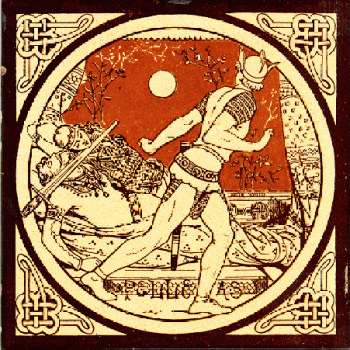The Victorian Perspective on Courtly Love as Revealed in Tennyson’s “Pelleas and Ettarre”
By: Emily Wright
Alfred Tennyson’s portrayal of Pelleas in “Pelleas and Ettarre” within Idylls of the King reveals how Victorian standards come into conflict with many aspects of courtly love. In comparison with its source material, the original Arthurian legends written by Thomas Malory in Le Morte Darthur, which constantly prioritize forbidden love affairs, Tennyson’s “Pelleas and Ettarre” offers a portrayal of Pelleas that serves as a Victorian critique on the nature of courtly love. Once Pelleas has discovered that his fellow knight, Gawain, has slept with Ettarre, the woman he loves, he places a sword against both of their throats in warning. This scene is depicted below, but the gesture is one of entirely different meanings in both Malory and Tennyson’s versions of the story.

In Malory’s version, this act stands only as a threat to a knight who has betrayed his vows of brotherhood, yet in Tennyson’s version, this act stands as the first instance of the elevation of Pelleas’ moral code above any other member of the Round Table. While Gawain breaks his sworn loyalties without hesitation, Pelleas controls his impulses and remains merciful, despite being wronged. In addition, Malory’s version of the story ends with the Damsel of the Lake magically providing Pelleas with true love and punishing Ettarre, since courtly love is valued above all else, but in Tennyson’s version, he instead chooses to offer a dissolution of the respect Pelleas once had for King Arthur and the Knights of the Round Table.
At the start of the poem, Pelleas is a young and naïve knight who holds the utmost respect for King Arthur and Queen Guinevere. He is loyal to Arthur as his King, and he even dreams of loving a woman who is “fair…and pure as Guinevere” (Tennyson line 42). To him, Guienevere is the ideal woman. Pelleas sees her as the epitome of fairness and purity – he knows nothing of her affair with Lancelot. Once he is wronged by Gawain and subsequently discovers the truth about the Queen, readers stand witness to the psychological unraveling of Pelleas. He asks, “Have any of our Round Table held their vows? …Why then let men couple at once with wolves” (Tennyson lines 523-526). He is stating here that the Knights of the Round Table are no better than animals in their moral code – vows do not mean anything to them when contested by their lustful desires. This idea brings to light how the standards of Victorian England changed the way in which courtly love is perceived. Pelleas’ outrage at the normalized adulterous behavior of the knights around him stands as a representation of how a Victorian reader would be reacting to these relationships. In Victorian society, courtly love is inherently wrong, and the fact that Tennyson chooses to have Pelleas exhibit that reaction, as opposed to focusing only on his own love, demonstrates this shift in cultural ideals.
Image Link: https://d.lib.rochester.edu/camelot/theme/pelleas-ettare





